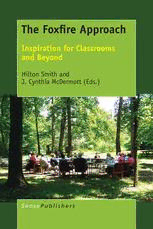
The Foxfire Approach: Inspiration for Classrooms and Beyond PDF
Preview The Foxfire Approach: Inspiration for Classrooms and Beyond
The Foxfire Approach The Foxfire Approach Inspiration for Classrooms and Beyond Edited by Hilton Smith Piedmont College, Demorest, USA and J. Cynthia McDermott Antioch University Los Angeles, USA A C.I.P. record for this book is available from the Library of Congress. ISBN: 978-94-6300-562-3 (paperback) ISBN: 978-94-6300-563-0 (hardback) ISBN: 978-94-6300-564-7 (e-book) Published by: Sense Publishers, P.O. Box 21858, 3001 AW Rotterdam, The Netherlands https://www.sensepublishers.com/ All chapters in this book have undergone peer review. The following chapter is reprinted here with permission from the publisher: Chapter 1: McDermott, J. C., & Smith, H. (2011). Eliot Wigginton: Foxfire – No inert ideas allowed here. In T. E. Smith & C. E. Knapp (Eds.), Sourcebook of experiential education: Key thinkers and their contributions (pp. 262–271). New York, NY: Routledge/Taylor & Francis Group. Printed on acid-free paper All Rights Reserved © 2016 Sense Publishers No part of this work may be reproduced, stored in a retrieval system, or transmitted in any form or by any means, electronic, mechanical, photocopying, microfilming, recording or otherwise, without written permission from the Publisher, with the exception of any material supplied specifically for the purpose of being entered and executed on a computer system, for exclusive use by the purchaser of the work. This collection of essays and reflections are dedicated to all of the students, teachers and community members who have supported Foxfire over its 50 year history. In particular we want to call out to Ann Moore for her long time commitment to the Foxfire Fund, to Jonathan Blackstock for keeping the Foxfire Magazine as a vital part of RCHS’ students lives, and to Hunter Mooreman for his sensitive and progressive leadership as chair of the Foxfire Board. Robert Murray is no longer with us but his love for the land and his knowledge about its ability to empower all who visited with him will always be missed. TABLE OF CONTENTS An Introduction ix Hilton Smith The Core Practices xv 1. No Inert Learning Accepted at Foxfire! 1 J. Cynthia McDermott and Hilton Smith 2. The Foxfire Museum and Heritage Center 11 Barry Stiles 3. Sound Reasoning: How the Foxfire Boys Emerged and Became a Community Institution 13 George Reynolds 4. Nurturing Civic Involvement: From Foxfire to Place-Based Education 19 Gregory A. Smith 5. Experiential Education: Exploring Foxfire and Other Approaches to Teaching 31 Clifford E. Knapp 6. Looking Home to Find My Way Forward: Insights from a Foxfire Student 45 Lacy Hunter Nix 7. We Are Foxfire 53 Joy Phillips 8. Core Practices in Use 57 Sara Alice Tucker 9. Foxfire and the Community: Making Real Introductions for 50 Years 65 Katie Lunsford 10. From Rabun County to Yonji County: The Foxfire Approach and Community-Based Education in Rural China 73 Sara G. Lam 11. Foxfire Goes to University: The Dance and the Disruptions 83 Jan Buley vii TABLE OF CONTENTS 12. Administrative Support for the Foxfire Approach to Teaching and Learning 93 Edd Diden 13. The Foxfire Course for Teachers: A Description of How It Works 101 Kiel Harell 14. From Active Learning to Activist Learning: Foxfire and the Bridge from Classroom to Community 115 Janet E. Rechtman 15. Project Based Learning, a Center for Design Class and Foxfire 121 Keith Phillips 16. Foxfire as a Need-Satisfying, Non-Coercive Process 129 J. Cynthia McDermott 17. Eliot Wigginton’s Relational Pragmatism 133 Frank Margonis 18. Research: How Do We Know Foxfire Approach to Teaching and Learning Works? 143 Steven R. Williams and Wilma Hutcheson-Williams 19. Some Concluding Thoughts 155 George Wood Contributors 159 viii HILTON SMITH AN INTRODUCTION Consider the contexts in which many, maybe most teachers try to teach today: (1) burdensome, detailed, curricula, often in the form of “standards,” sometimes accompanied by day-to-day prescribed instruction; (2) large classes (imagine a biology class with 32 students in which you are expected to conduct “experiments”); (3) disconnect between schools and the communities they serve; (4) school administrators who seem bent on enforcing whatever the “system” requires; (5) education hierarchies which seem remote from the realities of schools, students and teachers; (6) schools which seem designed to perpetuate the socio-economic disparities of our national culture. Did you miss anything you expected? Perhaps high-stakes tests, with teacher performance rated on students’ test scores? Less obvious, unless you are an educator tracking such things, is the reality of the short shelf-life of promising innovations. If you stay in the profession longer than five years, you are almost bound to be a participant in something promising, often promoted by your school or school district. Then the funding disappears, or the administration announces that program will be replaced by something they have decided would work better. Is the current trend of teachers leaving the profession after or before five years surprising? At one point Foxfire-sponsored initiatives at the high school included a video program, developing video versions of magazine articles, taught by Mike Cook, a former student in the magazine course. Bob Bennett created an outdoor education program as an alternative to required physical education courses. George Reynolds, skilled musician and certified in music education, involved students who had never had an opportunity to try their hand at music, especially the traditional music of Appalachia. One group of those students bonded into a string band, performing at schools, civic events, and clubs in the region. They appeared on the nationally televised program “Grand Ole Opry,” where the announcer forgot whatever they had selected as a name, stumbling out “The…uh…Foxfire Boys!” That name stuck and the group has stayed together for the intervening years. They have recorded their music. And this writer tried adapting Foxfire to required high school social studies courses, an initiative which provided valuable perspectives when we initiated Programs for Teacher. In light of the foregoing portrait of teaching, is it surprising that in 2016 we will celebrate the 50th anniversary of the Foxfire Magazine, published by students at ix
